The cooling system is designed to ensure optimal thermal conditions for engine operation
The engine cooling system is liquid, closed type, with forced circulation of coolant.
The main units and components of the cooling system include: radiator, fan with viscous drive clutch, fan casing, fan cowling, water channel housing, water pump, thermostats, channels and connecting pipes for the passage of coolant.
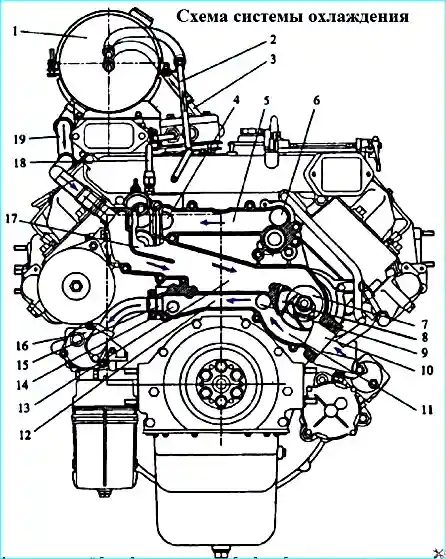
Fig. 1. Cooling system diagram: 1 - expansion tank, 2 - steam outlet pipe; 3 pipe for draining liquid from the compressor; 4 channel for liquid outlet from the right row of cylinder heads: 5 - connecting channel; 6 - channel for liquid outlet from the left row of cylinder heads; 7 - water pump inlet cavity; 8 water pump, 9 channel for liquid inlet to the left row of cylinder liners: 10 channel for liquid supply to the water pump from the radiator; 11 outlet cavity of the water pump; 12 connecting channel; 13 bypass channel from the water box to the water pump inlet; 14 channel for liquid inlet to the right row of cylinder liners; 15 channel for liquid outlet to the oil heat exchanger; 16 Oil heat exchanger; 17 - water box; 18 pipe for liquid supply to the compressor; 19 bypass pipe
The diagram of the cooling system with a fan coaxial with the crankshaft and with a viscous fan drive clutch is shown in Figure 1.
During engine operation, the circulation of coolant in the system is created by water pump 8.
The coolant from pump 8 is pumped into the cooling cavity of the left bank of cylinders through channel 9 and through channel 14 - into the cooling cavity of the right bank of cylinders.
Washing the outer surfaces of the cylinder liners, the coolant enters the cooling cavities of the cylinder heads through holes in the upper mating surfaces of the cylinder block.
From the cylinder heads, the heated liquid enters the water box of the water channel housing 17 through channels 4, 5 and 6, from which, depending on the temperature, it is directed to the radiator or to the inlet pump.
Part of the liquid is discharged through channel 15 into the oil heat exchanger 16, where heat is transferred from the oil to the coolant.
From the heat exchanger, the coolant is directed to the water jacket of the cylinder block in the area of the fourth cylinder.
The engine's thermal mode is regulated automatically:
- - two thermostats that control the direction of the liquid flow depending on the temperature of the coolant at the outlet of the engine. The nominal temperature of the coolant at the engine outlet should be within 85-90°C.
- - viscous coupling of the fan drive depending on the air temperature at the outlet of the CAC radiator.
The body of the water channels (Figure 1) is cast from a cast iron alloy and secured with bolts to the front end of the cylinder block.
The inlet 7 and outlet 11 cavities of the water pump, connecting channels 5 and 12, channels 9 and 14 supplying coolant to the cylinder block, channels 4 and 6 draining coolant from the cylinder heads, bypass channel 13, channel 15 for drainage into the oil heat exchanger, cavities of the water box 17 for installing thermostats, channel 10 for supplying coolant to the water pump from radiator.
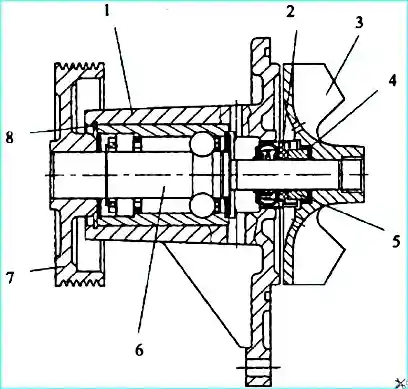
Fig. 2. Water pump: 1 housing; 2 oil seal; 3 impeller; sealing cuff; 5 friction ring; 6 - radial ball-roller bearing with shaft; 7 - pulley; 8 - thrust ring
The water pump (Figure 2) is of the centrifugal type, mounted on the water channel housing.
A radial double-row ball-roller bearing with a shaft 6 is pressed into the housing 1. The bearing ends are protected by rubber seals on both sides. The bearing is greased by the manufacturer.
No need to replenish the grease during operation.
Thrust ring 8 prevents the outer race of the bearing from moving in the axial direction. The impeller 3 and pulley 7 are pressed onto the ends of the bearing shaft.
The seal 2 is pressed into the pump housing, and its sliding ring is constantly pressed by a spring to the sliding ring 5, which is inserted into the impeller through a rubber cuff 4.
There are two openings in the pump housing between the bearing and the seal: lower and upper.
The upper opening is used to ventilate the cavity between the bearing and the seal, and the lower one is used to check the serviceability of the mechanical seal.
Liquid leakage from the lower its holes indicate a seal failure.
During operation, both holes must be clean, since their blockage will lead to bearing failure.
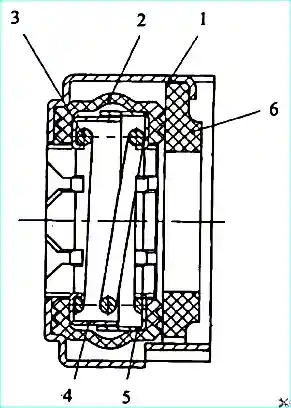
Fig. 3. Water pump seal: 1 outer housing; 2 - cuff; 3 spring; 4 inner frame; 5 - outer frame; 6 sliding ring
The water pump seal (Figure 3) consists of a brass outer casing 1, into which a rubber cuff 2 is inserted.
A spring 3 with an inner 4 and outer 5 frame is placed inside the cuff. The spring presses the sliding ring 6.
The sliding ring is made of graphite-lead hard-pressed antifriction material.
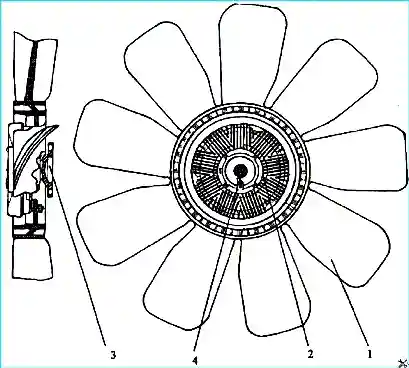
Fig. 4. Fan with drive clutch: 1 fan; 2 clutch; 3 hub; 4 - thermo-bimetallic spiral
Fan and viscous coupling (Figure 4).
Nine-blade fan 1 with a diameter of 710 mm is made of glass-filled polyamide, fan hub 3 is metal.
An automatically engaged viscous coupling 2 is used to drive the fan, which is attached to fan hub 3.
The operating principle of the coupling is based on the viscous friction of the liquid in small gaps between the driven and driving parts of the coupling. High viscosity silicone fluid is used as the working fluid.
The coupling is non-separable and does not require maintenance during operation.
The coupling is engaged when the air temperature at the radiator outlet rises to 61-67 °C.
The operation of the coupling is controlled by a thermal bimetallic spiral 4.
The fan is located in a fixed annular shell, rigidly attached to the engine.
The fan casing and the fan shell help to increase the air flow rate forced by the fan through the radiator.
The fan casing and the fan shell are connected by a U-shaped annular rubber seal.
The radiator (KAMAZ vehicles) is copper-soldered, to improve heat transfer, the cooling tapes are made with louvered notches, fastened with side brackets through rubber cushions to the frame side members, and the upper rod to the unifying air manifold.
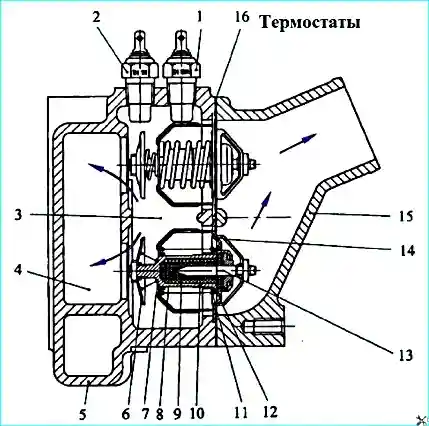
Fig. 5. Thermostats: 1 - temperature gauge sensor; 2 emergency overheating alarm sensor; 3 - engine fluid outlet channel; 4 fluid bypass channel to water pump inlet: 5 water box; 6 - bypass valve; 7 - bypass valve spring; 8 rubber insert; 9 - filler; 10 cylinder; 11 main valve spring; 12 main valve; 13 - piston; 14 body; 15 water pipe; 16 gasket
Thermostats (Figure 5) allow to accelerate warming up of a cold engine and maintain the coolant temperature not lower than 75 °C by changing its flow rate through the radiator.
Two thermostats with the opening start temperature of (80+2) °C are installed in parallel in the water box 5 of the water channel housing.
When the coolant temperature is below 80 °C, the main valve 12 is pressed against the seat of the housing 14 by the spring 11 and blocks the passage of the coolant into the radiator.
The bypass valve 6 is open and connects the water box of the water channel housing via the bypass channel 4 to the inlet of the water pump.
When the coolant temperature is above 80 °C, the filler 9, located in the cylinder 10, begins to melt, increasing in volume.
The filler consists of from a mixture of 60% ceresin (petroleum wax) and 40% aluminum powder.
The pressure from the expanding filler is transmitted through the rubber insert 8 to the piston 13, which, being squeezed outward, moves the cylinder 10 with the main valve 12, compressing the spring 11.
Between the housing 14 and the valve 12, an annular passage opens for the coolant into the radiator.
At a coolant temperature of 93 °C, the thermostat opens completely, the valve rises to a height of at least 8.5 mm.
Simultaneously with the opening of the main valve, the bypass valve 6 moves together with the cylinder, which closes the opening in the water box of the water channel housing, connecting it to the inlet of the water pump.
When the coolant temperature drops to 80 °C and below, under the action of the springs 7 and 11, valves 12 and 6 return to their original position.
To control the temperature of the coolant dency, two temperature sensors 1 and 2 are installed on the water box of the water channel housing.
Sensor 1 displays the current temperature value on the instrument panel, sensor 2 serves as an overheating alarm for the coolant.
When the temperature rises to 98 - 104 °C, the coolant overheating warning lamp lights up on the instrument panel.
Expansion tank 1 (Figure 1) is installed on the engine of KAMAZ vehicles on the right side along the vehicle direction.
The expansion tank is connected by a bypass pipe 19 to the inlet cavity of the water pump 13, a steam outlet pipe 2 to the upper tank of the radiator and to the liquid drain pipe from the compressor 3.
The expansion tank serves to compensate for changes in the volume of the coolant when it expands from heating, and also allows you to control the degree of filling the cooling system and helps remove air and steam from it.
The expansion tank is made of translucent propylene copolymer.
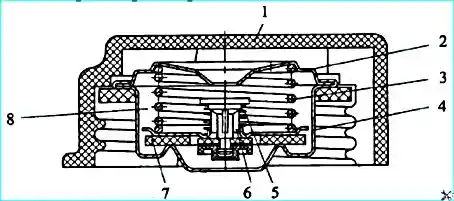
Fig. 6. Expansion tank cap: 1 - cap body; 2 - exhaust valve spring plate; 3 - exhaust valve spring; 4 exhaust valve seat; 5 intake valve spring; 6 intake valve assembly; 7 exhaust valve gasket; 8 - valve block
The expansion tank cap (Figure 6) with inlet valves 6 (air) and outlet (steam) valves is screwed onto the tank neck.
The outlet and inlet valves are combined into the valve block 8. The valve block is non-separable.
The outlet valve, loaded by spring 3, maintains excess pressure of 65 kPa (0.65 kgf/cm²) in the cooling system, the inlet valve 6, loaded by a weaker spring 5, prevents the creation of a vacuum in the system when the engine cools down.
The inlet valve opens and connects the cooling system to the environment when the vacuum in the cooling system is 1-13 kPa (0.01-0.13 kgf/cm²).
The engine is filled with coolant through the filler neck of the expansion tank tank.
Before filling the cooling system, you must first open the heating system tap.
To drain the coolant, open the drain taps of the heat exchanger and the pump unit of the pre-heater, unscrew the plugs on the lower tank of the radiator and the expansion tank.
Do not open the expansion tank cap on a hot engine, as this may cause hot coolant and steam to escape from the neck of the expansion tank.
Operating the car without the expansion tank cap is not allowed.
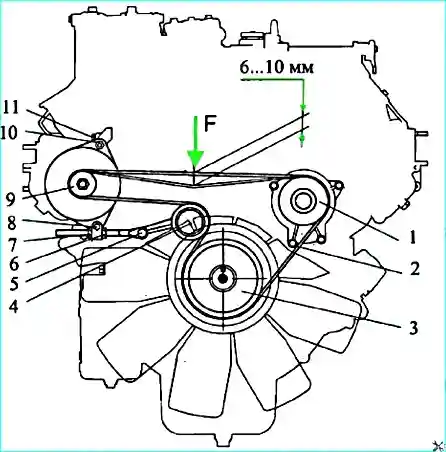
Fig. 7. Diagram for checking the tension of the alternator and water pump drive belts with the fan located along the crankshaft axis: 1 water pump pulley; 2 - poly V-belt; 3 crankshaft pulley; 4 - tension roller; 5,8,11 bolts; 6, 7, 10 nuts; 9 alternator pulley. F= 44.1 ± 5 H (4.5 ± 0.5 kgf).
Tension ADJUSTMENT (Figure 7) of the poly V-belt 2 of the generator and water pump drive for engines with a fan located along the crankshaft axis should be performed as follows:
- - loosen bolt 11 of the generator rear leg fastening, nut 10 of the generator front leg fastening, bolt 8 of the generator bar fastening, bolt 5 of the tension bolt fastening;
- - ensure the required belt tension by moving nut 6; nut 7 fix the position of the generator;
- - tighten bolts 5, 8 and 11, tighten nut 10.
After adjustment, check the tension:
- - a correctly tensioned belt 2, when pressed on the middle of the largest branch with a force of 44.1 ± 5 N (4.5 ± 0.5 kgf), should have a deflection of 6-10 mm.





